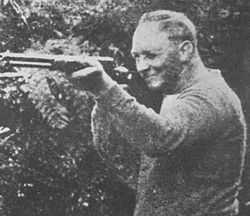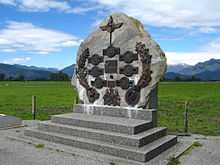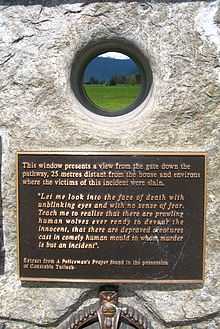Stanley Graham
| Stanley Graham | |
|---|---|
 | |
| Born |
12 November 1900 Kokatahi, New Zealand |
| Died |
21 October 1941 (aged 40) Hokitika, South Island, New Zealand |
Cause of death | Shot by police |
| Occupation | Farmer |
| Killings | |
| Date | 8–9 October 1941 |
| Location(s) | Kowhitirangi, South Island, New Zealand |
| Killed | 7 |
| Injured | 0 |
| Weapons |
Karabiner 98k Colt Police Positive Special(Stolen from Sgt Cooper's body) |
Eric Stanley George Graham (12 November 1900–21 October 1941) was a New Zealand mass murderer who killed seven people.
Early life
Graham was born and raised in Kokatahi, New Zealand. He then moved to Kowhitirangi, an agricultural district 12 miles from Hokitika in the South Island where he worked as a farmer and where he lived with his wife, Dorothy, and their two children. He became argumentative and alienated from the community from 1938 onwards, alleging that neighbours were poisoning his cows. As income from his farm dropped he fell into debt totaling over £550[1] and his behaviour towards others became more threatening. His behaviour took a turn for the worse and he started threatening and abusing neighbours passing his house. Graham and his wife practised target shooting out the back of their home in the middle of the night. Graham was an expert marksman and had an assortment of firearms.
During the first part of 1941 Graham was in dispute with the police who wanted to relieve him of his .303 rifle for war use. This was finally handed over on 15 July, but Graham and his wife still held a shotgun and two Winchester rifles, a .22 and a .405. In September, in Christchurch, Mrs Graham purchased, on her husband's behalf, a 7mm Mauser rifle and ammunition. This was the weapon Graham used to shoot his victims.[2]
The day of the rampage


On 8 October 1941 Graham confronted a neighbour with a rifle. Later that morning Constable Edward Best, 27, attempted to discuss the matter with Graham but backed off with Graham pointing two rifles out the window at him. Best retreated to Hokitika for back-up and returned to the farm with Sergeant William Cooper, 43, and Constables Frederick Jordan, 26, and Percy Tulloch, 35.
After a short conversation inside his house, Graham shot Sergeant Cooper. He then fired at Constables Jordan and Tulloch as they ran into the house, killing them both instantly with the one bullet. When the badly wounded Cooper attempted to leave to obtain help, Graham shot him dead on the path in front of the house. Constable Best was also shot and died three days later.[3]
Graham also shot an agricultural instructor, George Ridley, who had entered Graham's property to assist any wounded. After going to the front door, Ridley returned to the front gate and attempted to pick up an abandoned rifle, whereupon Graham shot him in the groin.[4] Graham then fled his house, but returned the next evening, when he killed home guardsmen Richard "Maxie" Coulson and Gregory Hutchison in a firefight.[5] During that engagement he was wounded in the right shoulder.[6]
More than 100 police and army personnel searched dense bush for Graham for 12 days, with orders to shoot on sight if they found Graham still armed. On 20 October an injured Graham was shot by Auckland Constable James Quirke as he walked out of the bush carrying his rifle. He died early the next day in Hokitika hospital,[7] and was buried at Hokitika Cemetery.[8] Constable Quirke reported Graham told him he was intending to give up that night.[5]
Reaction
A British-New Zealand movie, Bad Blood, was made about Stanley Graham and his chain of killings, as well as the dimensions of historical context and social injustice involved. There have been several biographical accounts of his life and the murders published in the intervening half-century since the tragedies occurred.
Notes
- ↑ http://www.murderpedia.org/male.G/g/graham-stanley.htm
- ↑ Willis, Howard Alan (1979), Manhunt : the story of Stanley Graham, Whitcoulls, pp. 48–55, ISBN 9780723306290
- ↑ "Memorial - Constable Edward Mark Best". New Zealand Police. Retrieved 2009-04-30.
- ↑ Willis, Howard Alan (1979), Manhunt : the story of Stanley Graham, Whitcoulls, pp. 86–7, ISBN 9780723306290
- ↑ 5.0 5.1 Carson, Christopher. Graham, Eric Stanley George 1900 - 1941. Dictionary of New Zealand Biography. Ministry for Culture and Heritage, Wellington. Updated 22 June 2007.
- ↑ Willis, Howard Alan (1979), Manhunt : the story of Stanley Graham, Whitcoulls, p. 131, ISBN 9780723306290
- ↑ Willis, Howard Alan (1979), Manhunt : the story of Stanley Graham, Whitcoulls, p. 205, ISBN 9780723306290
- ↑ "Cemetery enquiry". Westland District Council. Retrieved 11 October 2014.
References
- Andrew Brown (Scriptwriter, Producer): Mike Newell (Director): Bad Blood: Sydney: Hoyts: 1981 [Video]
- Rex Holliss: Killer on the Coast: The Story of Stan Graham: Wellington: Denis Glover: 1953, 1959.
- Howard Willis: Manhunt: The Story of Stanley Graham: Christchurch: Whitcoulls: 1979: ISBN 0-7233-0629-X
- Howard Willis: Bad Blood: The Story of Stanley Graham: Auckland: Fontana Collins: 1981: ISBN 0-00-634925-0